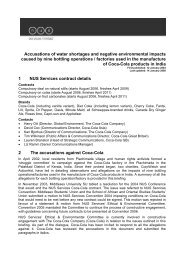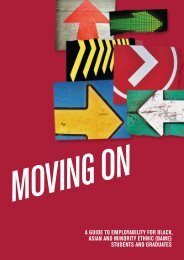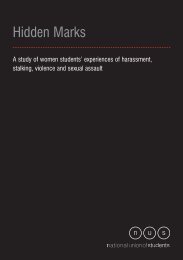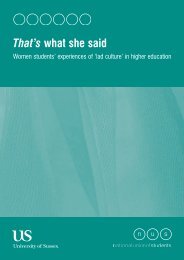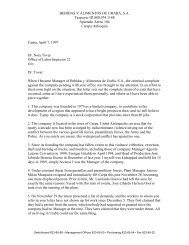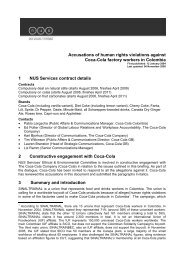No Place for Hate Crime - National Union of Students
No Place for Hate Crime - National Union of Students
No Place for Hate Crime - National Union of Students
Create successful ePaper yourself
Turn your PDF publications into a flip-book with our unique Google optimized e-Paper software.
<strong>No</strong> <strong>Place</strong> <strong>for</strong> <strong>Hate</strong><br />
Key findings<br />
The following summarises the headline findings <strong>of</strong> our<br />
research on students who have been targeted, or are<br />
worried about being targeted, because <strong>of</strong> prejudice<br />
against their sexual orientation and/or gender identity.<br />
Fears <strong>of</strong> victimisation<br />
Gay and lesbian respondents were more than 10 times<br />
as likely as heterosexual respondents to have concerns<br />
about being subject to abuse because <strong>of</strong> their sexual<br />
orientation.<br />
Almost half (46 per cent) <strong>of</strong> trans respondents reported<br />
that they were very or fairly worried about being subject<br />
to abuse because <strong>of</strong> their gender identity, as did 34<br />
per cent <strong>of</strong> those who opted not to disclose their<br />
gender identity.<br />
Respondents frequently described how they hid<br />
their sexual orientation and/or gender identity and<br />
were cautious about when and where they went out,<br />
<strong>for</strong> fear that they would become vulnerable to biasmotivated<br />
victimisation.<br />
“I pretend I am straight to people I don’t know very<br />
well or people I feel will react badly. I introduce<br />
my partner as my ‘friend’ at these times to avoid<br />
possible verbal or physical abuse.”<br />
The extent and nature <strong>of</strong> hate incidents<br />
Thirty-one per cent <strong>of</strong> lesbian, gay or bisexual (LGB)<br />
students surveyed had experienced at least one hate<br />
incident related to their sexual orientation some time<br />
during their current studies, compared to 2 per cent <strong>of</strong><br />
heterosexual respondents.<br />
Nine per cent <strong>of</strong> LGB respondents had experienced<br />
one or more <strong>for</strong>ms <strong>of</strong> physical abuse, while 7 per cent<br />
<strong>of</strong> LGB students had received abusive, threatening or<br />
insulting written communications.<br />
Fifty-five per cent <strong>of</strong> trans respondents said had<br />
been a victim <strong>of</strong> threatening, abusive or insulting<br />
words, threatening behaviour or threats <strong>of</strong> violence.<br />
The majority <strong>of</strong> these respondents believed this was<br />
motivated by prejudice against their gender identity.<br />
Twenty per cent <strong>of</strong> trans respondents had experienced<br />
at least one incident <strong>of</strong> physical abuse, while 38 per<br />
cent had experienced at least one incident <strong>of</strong> verbal<br />
abuse, threats <strong>of</strong> violence or threatening behaviour.<br />
“I was out clubbing with university friends. They<br />
would make it difficult <strong>for</strong> me to have a good night<br />
out with my friends – when at the bar they pushed<br />
and shoved, punched or kicked when I ordered<br />
drinks – on the dance floor they would be dancing<br />
behind me and throw themselves into the back <strong>of</strong> me<br />
and push me over.”<br />
Location <strong>of</strong> incidents and perpetrator pr<strong>of</strong>iles<br />
Strikingly, a large proportion <strong>of</strong> incidents occurred at<br />
the victim’s place <strong>of</strong> study. The exception being in<br />
cases <strong>of</strong> vandalism, property damage or theft, which<br />
predominantly occurred at or near the victim’s home.<br />
Moreover, many <strong>of</strong> these incidents occurred in the<br />
afternoon and evening, presumably during college and<br />
university campus open hours. In almost half <strong>of</strong> the<br />
cases (45 per cent), the perpetrator was believed to be<br />
a fellow student.<br />
The bulk <strong>of</strong> hate incidents were perpetrated by white<br />
male assailants, <strong>of</strong>ten young people in groups, who<br />
were not known by the victim.<br />
“What is most worrying to me is that I and the<br />
perpetrator are both Year 1 Social Work students.”<br />
Reporting <strong>of</strong> hate incidents<br />
Our research showed that hate-related incidents<br />
against LGBT students went widely unreported. Some<br />
8–13 per cent <strong>of</strong> incidents involving prejudice against<br />
the victim’s sexual orientation were reported to the<br />
victim’s institution. Levels <strong>of</strong> reporting to the police were<br />
even lower.<br />
Those who did report incidents <strong>of</strong>ten chose to do so to<br />
academic staff (42 per cent) or student <strong>of</strong>ficers (29 per<br />
cent), rather than non-teaching staff (12 per cent).<br />
Reasons given <strong>for</strong> victims not reporting incidents to<br />
their institution included shame and embarrassment,<br />
fear <strong>of</strong> reprisals and retribution, and concern over<br />
having to disclose personal details.<br />
4



